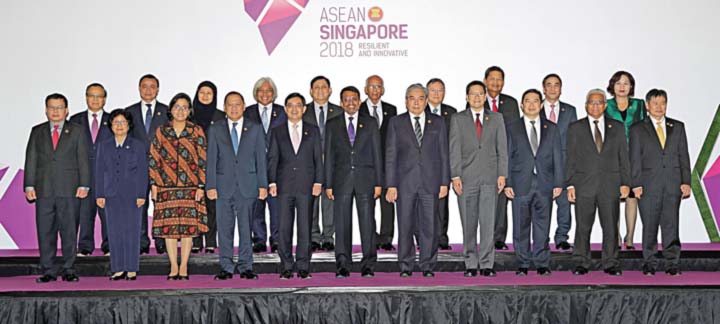
With thousands of Filipino workers deployed all over the world, the local economy is being pumped with about $25 billion of fresh dollar infusion from their cash remittances alone, and accounted for about 10 percent of its gross domestic product (GDP) in recent years.
The constant supply of greenbacks from overseas Filipino workers (OFWs) was a pillar of the local growth story, pushing private consumption upward and supporting the value of the local currency against the dollar.
But in recent months, the decade-old industry has been showing signs of a slowdown—moving into a more “normalized” growth number from years of rapid expansion.
At the end of the year’s first half, for example, money sent by Filipino migrant workers declined by 4.5 percent to hit $2.357 billion during the month.
The dollar volume of the dollars sent home by OFWs in June was $112 million lower than the previous month’s aggregate cash remittances and $110 million short of the remittances in June 2017.
This was on the back of rising labor issues particularly in the Middle East.

BPO sector
The “normalization” of remittances puts focus on another major dollar driver of the country, one that is a relatively new sector and has been on a rapid expansion in the last years—the business-process outsourcing (BPO) industry.
In 2017 the Philippines was said to be the largest location for delivery of contact services in the rest of the world, leaving India in the second place, Contact Center Association of the Philippines (CCAP) said, citing international data and research.
Under the BPO industry’s 2022 road map, the industry is projected to post an annual growth rate of 8 percent to 9 percent and by end-2022, is seen to generate revenues of up to $38.9 billion.
This has sparked talk of the BPO industry outpacing remittances when it comes to being the top dollar driver of the country.
 BSP welcomes structural shift
BSP welcomes structural shift
Bangko Sentral ng Pilipinas (BSP) Deputy Governor Diwa Guinigundo welcomed the forward-looking development, saying having two strong dollar drivers in the country will always be a win-win situation for the economy.
“We call both remittances and BPO revenues as structural flows in the current account. In many ways, both have a large degree of stability and certainty: our overseas workers are highly in demand and new markets are continually found. On the other hand, BPO revenues are also very steady because we have a good cost advantage that translates into stable demand for our workers and processes here. Businesses can be competitive in business upcycle while they can cut costs during business downcycle,” Guinigundo told the BusinessMirror.
Structural shift
He however, recognized the possibility of a possible structural shift in the country’s main dollar source down the road.
“It is possible for BPO revenues to overtake remittances in terms of dollars and cents. Remittances are growing by around 4 percent average on an annual basis while BPOs could grow by as much as 9 percent to 10 percent. Unless new markets are found and new skills are offered to the global markets, and BPO workers continue to be competitive against their counterparts, we might be seeing such convergence in a few years and remittances being overtaken by BPOs,” the central bank official added.
In their annual target assessment of external indicators, economic managers chalked up a 4-percent growth in remittances for 2018, from the $28.0 billion total in 2017. Last year, remittances grew 4.3 percent.
In the first seven months of 2018, however, growth is still lagging behind the government’s projection at 3 percent for the January to July period of the year.
Guinigundo further said the structural shift of the Philippines’s main dollar driver from remittances to BPOs shows no immediate downside risk to the economy.
“In fact, I would like to see the day when we finally break away from dependence on foreign remittances because we shall have been able to create job opportunities for our skilled labor right here in the Philippines. The focus on infra and increasing our productive capacity is a step in the right direction,” he said.
“On BPOs, it would be most desirable when our local firms are the actual ones benefitting from the natural talent and skills of our own people—whether in services, manufacturing or engineering,” he added.
Downside to BPOs
ING Bank Manila economist Nicholas Antonio Mapa, however, said remittances will continue to be the most stable and structural flow of foreign currency into the country.
“Throughout the years, remittances have been able to grow at a steady pace, now seen to be plateauing at a 3-percent to 4-percent range, but given the inherent driving factor behind a remittance, we probably won’t be seeing remittances contract altogether,” Mapa told the BusinessMirror.
“These transfers are sent because family members look to provide or augment incomes back home in the Philippines, and this altruistic nature of sending a remittance is stronger than any incentive as it is ingrained in our Filipino familial culture. Come hell or high recessions, remittances will flow,” he added.
BPO centers, on the other hand, have provided an additional source of structural flows but just like remittances, are likely to see a plateauing in growth rates as the sector moves into maturity, according to him.
“I don’t see the shift happening any time soon, and am actually skeptical that BPO net exports will ever overtake remittances,” Mapa said.
“What I do foresee is that these structural flows will continue to expand at a steady pace and provide support to the country both as a stable source of FX and as a driver for the local economy through the provision of incomes [earned onshore and offshore] and employment for the industries that support them,” he added.
“For now, the structural flows will continue, to help the Philippines ride out this current increased outflow of foreign exchange as we move into our new growth trajectory,” he said.
Image credits: Spaceport9 | Dreamstime.com, Paul Hilton/Bloomberg News, ric.adb.org














 BSP welcomes structural shift
BSP welcomes structural shift



















